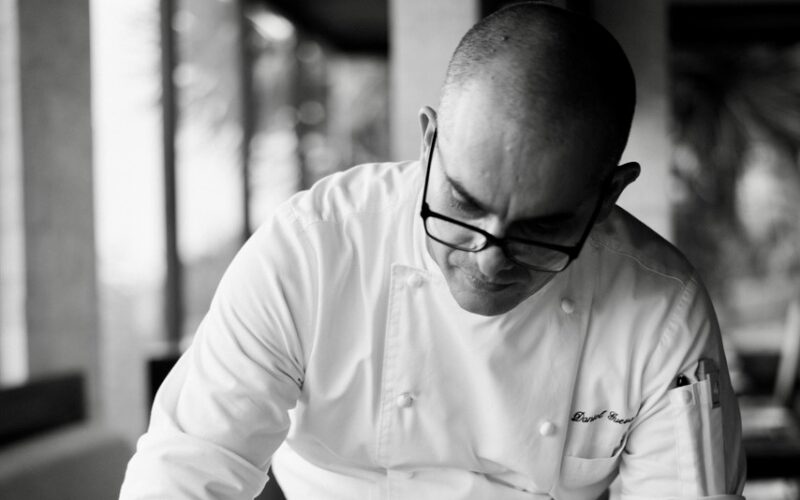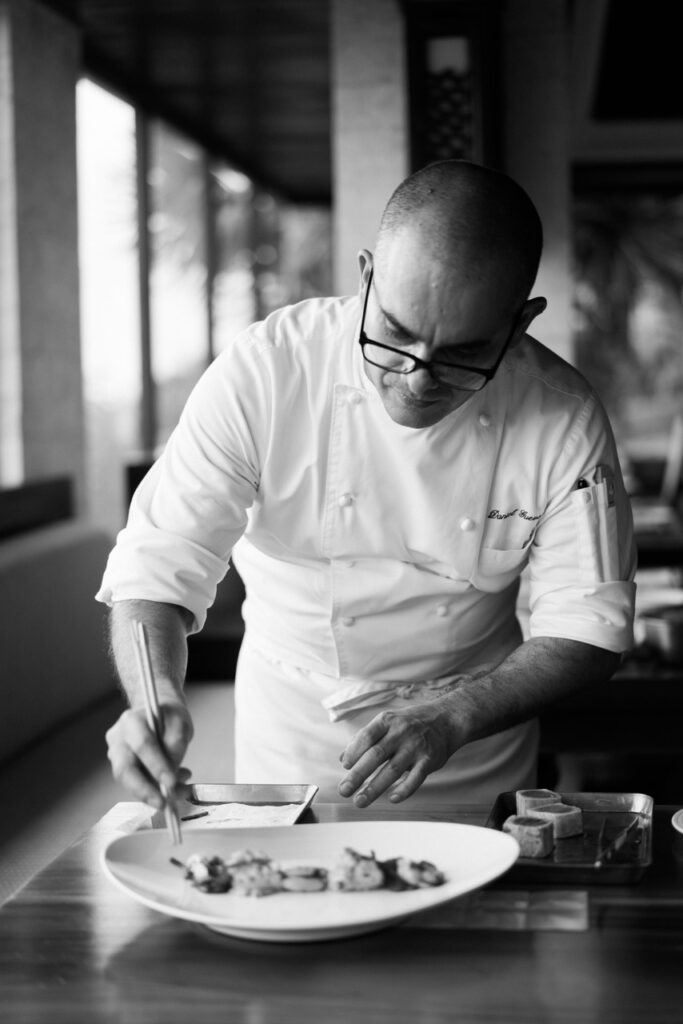As a chef for over two decades now, what Guevara love most about his job is the unique ability to delight guests and engage their senses in a truly transformative way. Cooking is not just about preparing meals, he says. It’s about crafting experiences that evoke memories, emotions and connections.
With over 20 years of culinary experience, fueled by a delightful mix of self-motivation and ambition, he sets out to exceed expectations and enchant guests with dishes that come straight from the heart. Raffles and Fairmont Makati welcomes its newest executive chef – Daniel Guevara.
In this capacity, he expertly manages a team of over 100 chefs across eight restaurants, showcasing his unwavering passion for cooking and expertise in culinary operations.
What do you love the most about your job?
As a chef, what I love most about my job is the unique ability to delight guests and engage their senses in a truly transformative way. Cooking is not just about preparing meals; it’s about crafting experiences that evoke memories, emotions, and connections. There’s something incredibly rewarding about watching a guest take that first bite and see their eyes light up – that moment of joy is what makes all the hard work worthwhile.
The creativity and innovation opportunities in the culinary world are another aspect that I find exhilarating. Each dish is a blank canvas, allowing me to experiment with flavors, textures, and presentation. Whether it’s reimagining traditional recipes or incorporating unexpected ingredients, I relish the challenge of pushing culinary boundaries. This freedom to create not only keeps my passion alive but also allows me to continuously learn and grow as a chef.
How do you describe your overall cooking philosophy?
My overall cooking philosophy is rooted in the rich, vibrant traditions of Mediterranean cuisine, which emphasizes fresh, high-quality ingredients, bold flavors, and time-honored cooking techniques. I believe that food should not only nourish the body but also be a celebration of culture and community. The Mediterranean scene, with its focus on seasonal produce, and aromatic herbs, inspires my culinary foundation and informs my approach to crafting dishes that are both delicious and wholesome.
However, as I’ve evolved in my culinary journey, I have embraced a more modern and refined fine dining style when the occasion calls for it. This evolution allows me to blend traditional Mediterranean flavors with innovative techniques and presentation styles, creating a harmonious balance between the familiar and the contemporary. I relish the challenge of taking classic dishes and reimagining them, using modern culinary trends and global influences to elevate the dining experience.
What is your favorite and least favorite dish/drink to prepare?
My favorite dish to prepare is undoubtedly any new creation that pushes the boundaries of my culinary imagination. There’s an undeniable thrill in experimenting with unexpected ingredients, flavors, and presentation styles. Each new dish is like a blank canvas, allowing me to combine my knowledge with inspiration drawn from the seasons, cultures, and experiences. The process of refining a concept, testing new combinations, and ultimately balancing flavors to create something unique is incredibly rewarding. When a new dish resonates with guests and brings them joy, it solidifies the excitement I feel during the creative process.
Conversely, my least favorite dishes or drinks to prepare are those that rely on unhealthy, low-quality products. Cooking is an art form, and I believe that it should celebrate quality and integrity in ingredients. When I am forced to work with subpar items, it diminishes the essence of my culinary philosophy, which prioritizes health, flavor, and sustainability. Such dishes often lack the depth and satisfaction that come from using fresh, high-quality ingredients, and it can feel disheartening to serve something that doesn’t align with my commitment to culinary excellence.
How would you describe the dining habits and tastes of Filipinos?
I would describe the dining habits and tastes of Filipinos as an intricate tapestry woven from a rich history of diverse culinary influences. Filipino cuisine is a beautiful reflection of the country’s colonial past and trade relationships, showcasing a harmonious blend of native, Malay, Chinese, Spanish, and American flavors and techniques. This fusion results in a unique culinary identity that is both vibrant and multifaceted.
At the core of Filipino dining is the strong influence of Spanish culinary traditions. This is evident in iconic dishes such as adobo, which demonstrates a perfect marriage of marinating and braising techniques rooted in Spanish cooking. Similarly, dishes like caldereta, a hearty beef stew, showcase
Spanish-inspired flavors while incorporating local ingredients and cooking styles. These dishes not only highlight the rich heritage of the Philippines but also exemplify the adaptive nature of Filipino cooks who have embraced and reinterpreted these culinary techniques over generations.
Moreover, Filipino dining habits often revolve around communal eating, where meals are enjoyed together among family and friends. This practice fosters a sense of connection and celebration, infusing each gathering with warmth and togetherness. The array of flavors—from the savory depth of sinigang to the sweetness of leche flan—reflects the Filipino palate’s love for complexity, balancing sweet, sour, and salty elements in each dish.
The emphasis on fresh, local ingredients mirrors the importance of the country’s diverse terroir. The use of seasonal fruits, vegetables, and seafood showcases the bountiful resources available, with each region contributing its specialties to the overall culinary landscape.
How would you describe the people who dine at your restaurant?
The patrons who dine at my restaurant reflect a wonderfully diverse and dynamic blend of cultures, embodying both the cosmopolitan nature of an international brand and the rich local flavor of the Filipino market. Our clientele is truly multicultural, attracting visitors from various backgrounds and nationalities who come together to savor our culinary offerings, creating a vibrant tapestry of experiences and stories.
As a result of being part of an international brand, we often see guests who are adventurous food enthusiasts eager to explore new flavors and techniques. They come with an open mind, ready to experience innovative dishes that showcase both global trends and local ingredients. This diverse group includes international travelers, expatriates, and residents who appreciate the elevated dining experience we offer.
Why do you think food and culture are closely tied together?
The relationship between the two stems from the way food is not just about sustenance but also a powerful medium for expressing cultural heritage and shared traditions.
At its core, tradition plays a vital role in shaping culinary practices. Recipes are often passed down through generations, carrying with them stories of family gatherings, rituals, and special occasions. These traditional dishes serve as a connection to the past, allowing individuals to honor their
ancestors and maintain a sense of belonging within their cultural group. Through these practices, food becomes a way to preserve history, fostering pride in one’s heritage.
The innovation arises from tradition, as culinary practices evolve over time in response to changing tastes, ingredients, and influences. Chefs and home cooks often take traditional recipes and reinterpret them, blending them with contemporary techniques or global flavors. This dynamic process not only keeps the culinary culture vibrant but also allows it to adapt to new contexts while still honoring its roots.
What is your favorite Filipino dish?
Two of my favorite Filipino dishes are beef caldereta and tinola, each offering a unique taste of Filipino culinary traditions.
Beef caldereta is a rich and hearty dish that showcases tender beef stewed in a thick tomato-based sauce, often enhanced with liver spread for an extra depth of flavor. Whilst tinola is a lighter, yet equally delicious option.
Both dishes reflect the rich culinary heritage of the Philippines, showcasing the importance of ingredients and the vibrant flavors that Filipino cuisine is known for. Whether it’s the indulgent beef caldereta or the soothing tinola, each dish tells a story of culture, family, and tradition.






